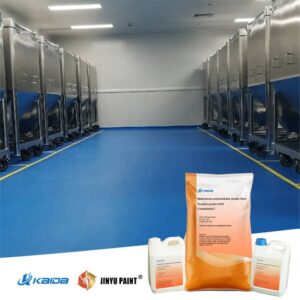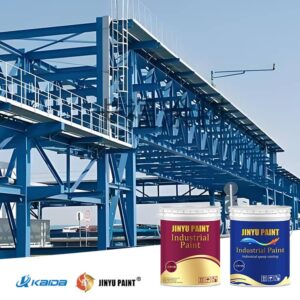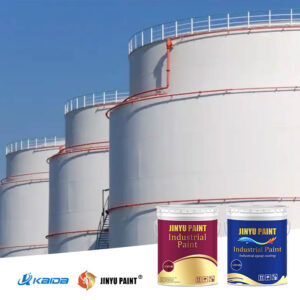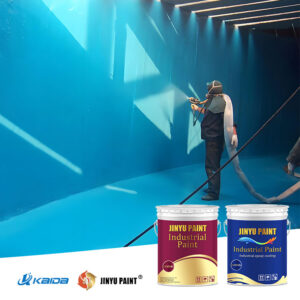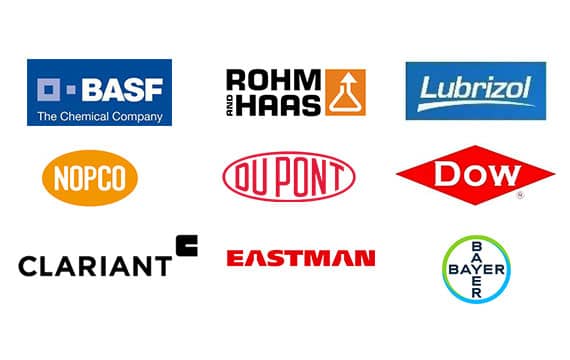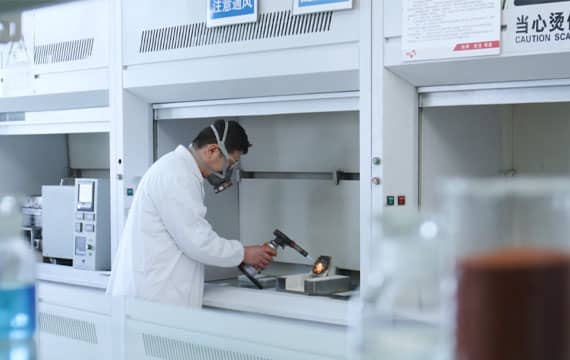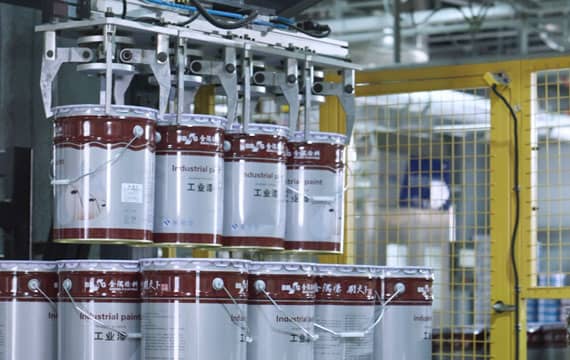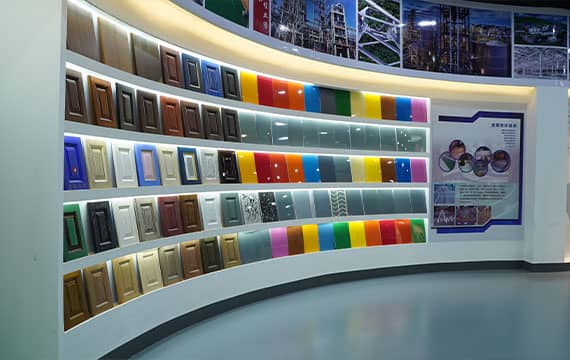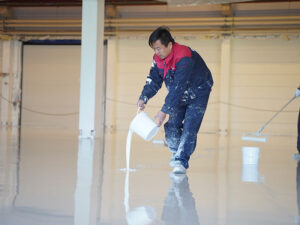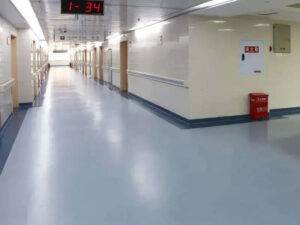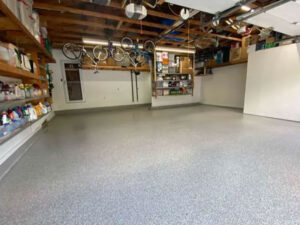
JINYU PAINT® Polyurethane Paint
Polyurethane paint, also known as polyurethane coating, is a high-performance paint widely used in construction, furniture, automotive, and industrial equipment. It is formed by the reaction of polyisocyanate (hardener) and polyhydroxy resin (main agent), with its molecular structure containing numerous urethane bonds (-NH-CO-O-), hence the name. Polyurethane paint offers a tough film, glossy finish, strong adhesion, and excellent resistance to water, abrasion, corrosion, and chemicals. It provides both protective and decorative effects.
Polyurethane paint is a high-performance synthetic resin coating with a tough film, strong adhesion, and excellent weather resistance. It is widely used in furniture, automotive, construction, and industrial applications for protection and decoration. However, its complex application process, environmental sensitivity, and health risks require careful handling and safety measures.

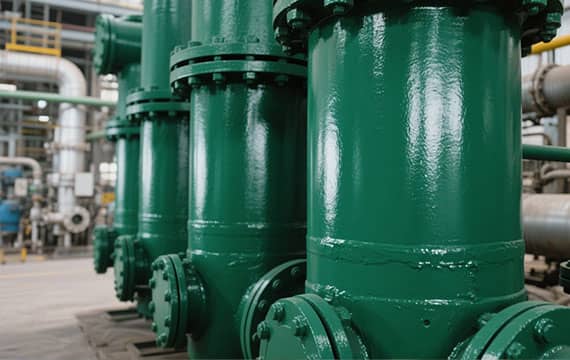
JINYU PAINT® Polyurethane PRODUCTS
Showing all 8 results
-

Anti-slip Self-leveling Anticorrosive Load-bearing Polyurethane Concrete Floor Paint
Read more -

BGA-40 Acrylic Polyurethane Topcoat
Read more -

High Performance Spray Polyurethane Finish
Read more -

PU3600 Polyurethane Ultra Abrasion Resistant Finish
Read more -

Self-leveling Heavy-duty Anticorrosive Polyurethane Concrete Floor Coating
Read more -

Water-Based Polyurethane Coating Finish
Read more -

WPU100 High Gloss Clear Water-based Polyurethane Finishs
Read more -

WPU100 Water-based Polyurethane Floor Finish
Read more
Composition and Types of Polyurethane Paint
Polyurethane paint is typically divided into two-component (2K) and one-component (1K) types. Two-component polyurethane paint consists of an isocyanate prepolymer (hardener) and a hydroxyl-containing resin (main agent), which chemically react to form a high-molecular-weight polyurethane structure. One-component polyurethane paint does not contain hydroxyl components and is usually partially cured during storage, requiring only a small amount of thinner before application. Additionally, polyurethane paint can be further classified based on its film-forming resin, such as acrylic polyurethane, alkyd-polyurethane, and polyester-polyurethane.

Key Properties of Polyurethane Paint
- High Mechanical Strength: The paint film is extremely hard and flexible, making it suitable for high-wear areas like floors and decks.
- Excellent Adhesion: It bonds well with various substrates, including wood, metal, and plastic.
- Weather Resistance: Polyurethane paint resists UV rays, moisture, and temperature fluctuations, maintaining color and gloss.
- Chemical Resistance: It withstands acids, alkalis, oils, and solvents, making it ideal for chemical plants, ships, and oil rigs.
- Adjustable Formulation: By altering the ratio of isocyanate and hydroxyl resin, different hardness, elasticity, and weather resistance levels can be achieved.
Applications of Polyurethane Paint
Due to its superior performance, polyurethane paint is widely used in:
- Furniture Industry: High-end wood furniture coatings for durability and aesthetics.
- Automotive Industry: Car body coatings, underbody protection, and interior plastic coatings.
- Construction Industry: Anti-corrosion and decorative coatings for steel structures, wooden floors, and infrastructure.
- Industrial Equipment: Protective coatings for pipelines, storage tanks, and chemical plant machinery.
- Marine Industry: Anti-corrosion and decorative coatings for ship decks and cabins.
Storage of Polyurethane Paint
During application, follow instructions carefully, ensure proper mixing, and use within the specified time. Avoid contact with water, acids, or bases, and ensure proper ventilation. Keep away from open flames. Store in a cool, dry place, with a typical shelf life of one year.
Polyurethane Paint & Coating FAQs
1. Can You Paint Over Polyurethane?
Yes, you can paint over polyurethane, but proper surface preparation is crucial. Lightly sand the polyurethane-coated surface with fine-grit sandpaper (220-grit) to create a rough texture for better paint adhesion. Clean the surface to remove dust, then apply a high-quality bonding primer designed for glossy surfaces. Once the primer dries, you can use acrylic latex paint, oil-based paint, or chalk paint, depending on the desired finish. For optimal results, ensure the paint is compatible with polyurethane coatings.
2. Can You Apply Polyurethane Over Paint?
Polyurethane can be applied over paint to add durability and a protective finish. It works best over acrylic latex paint, chalk paint, or oil-based paint. Ensure the paint is fully cured (typically 24–48 hours) before applying water-based or oil-based polyurethane. Use a brush or foam roller for even application, and sand lightly between coats for a smooth finish. Note that oil-based polyurethane may yellow over time, especially on white or light-colored paints.
3. How to Paint Over Polyurethane Without Sanding?
If sanding isn’t an option, use a liquid deglosser or chemical sanding solution to dull the polyurethane surface. Apply a high-adhesion primer like Zinsser BIN or Kilz, which bonds well to glossy surfaces. Once the primer dries, you can paint over it with latex or acrylic paint. However, sanding remains the most reliable method for long-lasting results.
4. Will Paint Stick to Polyurethane?
Paint can stick to polyurethane if the surface is properly prepared. Sanding and priming are essential to ensure adhesion. Without preparation, paint may peel or chip over time. For best results, use a primer designed for glossy surfaces, followed by a compatible topcoat paint.
5. Can You Use Polyurethane Over Chalk Paint?
Yes, polyurethane is commonly used to seal and protect chalk paint. Water-based polyurethane is ideal for maintaining the paint’s matte finish, while oil-based polyurethane adds durability but may slightly yellow over time. Apply thin, even coats with a brush or foam roller, and allow proper drying between layers.
6. How Long Should Paint Dry Before Applying Polyurethane?
Wait at least 24–48 hours for latex or acrylic paint to dry before applying polyurethane. Oil-based paint may require 72 hours or more to fully cure. Applying polyurethane too soon can trap moisture, leading to bubbles or poor adhesion.
7. Can You Mix Paint with Polyurethane?
Mixing paint with polyurethane is not recommended, as it can alter the chemical properties and reduce durability. Instead, apply paint first, let it dry, then seal it with a clear polyurethane topcoat. Some specialty products, like tinted polyurethane, are designed for color mixing but should be used as directed.
8. Does Polyurethane Yellow Over Time?
Oil-based polyurethane tends to yellow, especially on white or light-colored surfaces. Water-based polyurethane remains clear and is a better choice for maintaining the original paint color. For minimal yellowing, choose a non-yellowing formula like Minwax Polycrylic.
9. Can You Spray Polyurethane Over Paint?
Yes, polyurethane can be sprayed over paint using an HVLP (High Volume Low Pressure) sprayer or aerosol cans for even coverage. Thin the polyurethane slightly (if needed) and apply in light, overlapping coats. Ensure proper ventilation and wear protective gear when spraying.
10. What’s the Difference Between Polyurethane Paint and Polyurethane Coating?
- Polyurethane Paint contains pigments and provides both color and protection, commonly used in automotive and industrial applications.
- Polyurethane Coating is typically clear and used as a protective topcoat over paint, wood, or metal to enhance durability and resistance to scratches, chemicals, and UV rays.
11. How to Clean a Paint Brush After Using Polyurethane?
For water-based polyurethane, rinse brushes with warm, soapy water immediately after use. For oil-based polyurethane, clean with mineral spirits or paint thinner, then wash with soap and water. Never let polyurethane dry on brushes, as it can ruin them.
12. Is Polyurethane Paint Waterproof?
Polyurethane paint and coatings are highly water-resistant but not entirely waterproof. They provide excellent protection against moisture, making them ideal for furniture, floors, and marine applications. For full waterproofing, epoxy or specialized sealants may be required.
13. Can You Use Polyurethane on Painted Cabinets?
Yes, polyurethane adds durability to painted cabinets, especially in high-traffic areas like kitchens. Use water-based polyurethane for a clear finish or oil-based for added hardness (with potential slight yellowing). Apply with a foam brush to minimize brush marks.
14. What Happens If You Don’t Sand Before Polyurethane?
Skipping sanding can lead to poor adhesion, causing the polyurethane to peel or bubble. Light sanding (or deglossing) ensures a strong bond between layers. Always sand between coats for a smooth, professional finish.
15. Can You Apply Polyurethane Over Latex Paint?
Yes, but ensure the latex paint is fully cured (up to 7 days for thick coats). Use water-based polyurethane for compatibility and minimal yellowing. Oil-based polyurethane can be used but may alter the paint’s appearance over time.
How Featured JINYU Paints Are Made?
JINYU® starts with the careful selection of high-quality raw materials, including resins, pigments, additives, and solvents. Each component is chosen for its ability to meet stringent quality standards.
The selected raw materials are combined in precise proportions in state-of-the-art laboratories. JINYU®’s chemists and material scientists formulate coatings that achieve specific characteristics, such as durability, adhesion strength, and environmental responsibility.
Rigorous quality control measures are in place throughout the manufacturing process. JINYU®’s coatings undergo various tests and inspections to ensure they meet or exceed industry benchmarks.
After formulation and quality assurance, the coatings are produced in large batches using advanced machinery. They are then carefully filled into containers and labeled, maintaining product integrity.
JINYU® boasts a wide range of color options and customization possibilities. Color experts work closely with customers to create unique shades and finishes to suit their specific projects.
JINYU® is committed to sustainability. The company actively seeks eco-friendly solutions, offering low-VOC coatings and environmentally responsible formulations.
JINYU® provides excellent customer support. The team offers guidance on product selection, application techniques, and troubleshooting to ensure customers achieve the best results.
The Applications of Featured JINYU PAINT®
JINYU PAINT® provides a comprehensive range of high-performance coatings, including epoxy floor coatings, industrial coatings, fireproof coatings, and architectural coatings for interior and exterior walls. Our solutions are designed for durability, aesthetics, and protection across various applications, from residential and commercial buildings to industrial facilities and fire safety projects. Whether you need seamless flooring, corrosion resistance, fire protection, or decorative wall finishes, JINYU PAINT® offers expert coatings to enhance and protect every surface.










LATEST FAQS at JINYU PAINT®
FAQ
- Soybean Processing Flooring Solutions: Why Urethane Mortar is the Industry Standard
- Building a Fortress for Pet Food Safety: Why Specialized Pet Food Plant Flooring is Essential
- Pharmaceutical Flooring Guide: Why Urethane Mortar is the Top Choice for GMP Facilities
- The Ultimate Guide to Food Processing Flooring: Revolutionizing Pre-made Food Production with Urethane Mortar Systems
- The Ultimate Seafood Processing Flooring Solution丨KAIDA JINYU® Delivers High-Performance Floors
Contact Us
Contact: Ms. Sabella Wei
Phone: 86-022-83859963
Whatsapp: 15822925523
